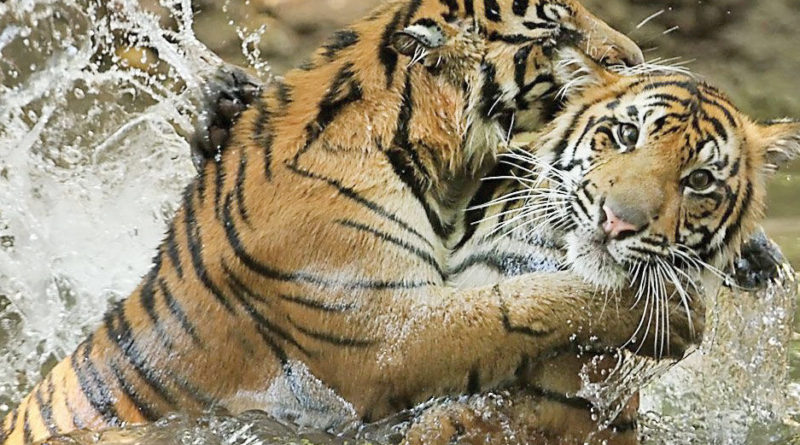Labor of love
Manda Butler, animal care manager of mammals at the Cameron Park Zoo in Waco, said she is a natural mother to anyone or anything, especially anything helpless and defenseless. She said her mothering tendencies were pushed to the limit in 2011 when she became a surrogate mother to two Sumatran tiger cubs less than an hour after their birth.
When the cubs’ mother, Maharani, had reached her due date, Butler said she and her staff were all on “birth watch,” monitoring her closely for behavioral changes that indicated she was ready to deliver. While watching the tiger through closed-circuit TV, she noticed Maharani become very nervous and agitated as she went into labor. When Indah, her first female cub was born, Butler said that Maharani’s initial reaction to the first cub was not good.
“She was hesitant about the noises her cub was making. Sometimes first-time moms don’t react well,” she said. “Maharani was ‘plucking’ at the cub with tiny bites, and would not lay down with it. She didn’t carry it properly by the nape of the neck, either.”
Butler and her staff watched Maharani pick the female cub up, place her in another stall, and leave her, a sure indicator that the cub was not wanted. They immediately intervened to care for her and discovered that she had a small puncture wound on her neck, which required even more attention and care. “We were concerned about the cub’s breathing, too,” she said.
Knowing a second cub was on its way, Butler left two stalls open in case Maharani rejected it also. Fourteen hours later, she delivered her second cub, which Maharani also left in a stall by himself. On their next monitoring cycle, the staff found the second cub who was crying for attention, and Butler quickly stepped in with her staff to care for him.
Butler said that Maharani may have rejected her cubs because of the “inherent stressors” in any zoo environment, especially for first-time moms. “Though zoo staff does everything to mitigate these stressors, there are sometimes unknown triggers that are unpreventable,” she said.
Butler explained that in such cases as these, the staff will care for the cubs with the intent of reintroducing them to their mother once they are stable. Because Indah had the puncture wound that required constant care, she decided to keep Bugara out with her as well so that they could be cared for at the same time.
“There are a lot of us here who have a heart for animals,” Butler said. “It takes more than a village to raise two baby tiger cubs.” She and four other keepers gave them 24-hour round-the-clock care, rotating shifts to stay with the cubs overnight. “Me and one other keeper did three straight days of bottle feeding, rotating every four hours,” she said. Butler explained that not every keeper had the training to do the bottle feeding at the time. “The cubs’ sucking instinct wasn’t very strong, and we didn’t want them to aspirate (choke on too much milk).”
After the first two weeks, the cubs no longer required constant watch. At two and a half weeks, Butler and her staff members still rotated sleeping with the cubs to give them their regular four-hour feedings, but they began to gradually increase the time between feedings. “A couple of us found it was easier to take the night shift with them,” she said. “I did midnight to 9 a.m. I would go home and be with my family, take a nap, then go do it all over again.”
When the cubs were two months old, Butler introduced them to the tiger exhibit where Maharani and the cubs’ father lived. Maharani continued to ignore her cubs, though the father indicated interest in them by “chuffing at them, a sound almost like a purr, but more like a whoosh,” said Butler. Although the cubs could not be placed back with Maharani, they still became well socialized to both the adult tigers and to human zoo visitors.
At four months old, the cubs were moved to a night barn where they were allowed to become more independent, sleeping through the night without the staff present. At six months, Butler and her staff slowly began to let go of their young wards. They began training the cubs through a wire mesh, gradually distancing themselves from the cubs so they could survive on their own. They also began rotating the cubs in the tiger exhibit for visitors to watch.
Although Butler and her staff reared the cubs using the best scientific methods, she said, “It is always better for cubs to be raised by their natural mother whenever possible. We don’t advocate hand rearing. Nobody can be as good a mom as the female tiger herself can be. These are powerful, formidable animals; those instincts are there forever. There is a lot of scientific training required to foster their natural traits while managing them in captivity.”
While Butler is passionate about educating the public on animal husbandry and species conservation, she admitted, “I have my own 12-year-old son, but the cubs began to feel like my own children. As much as I tried not to anthropomorphize them, I still celebrated their milestones, like when they took their first steps and when they were weaned. Indah was always independent; she liked to explore, but Bugara stuck by my side. He was my ‘big boy.’ You can’t help but fall in love with them.”



